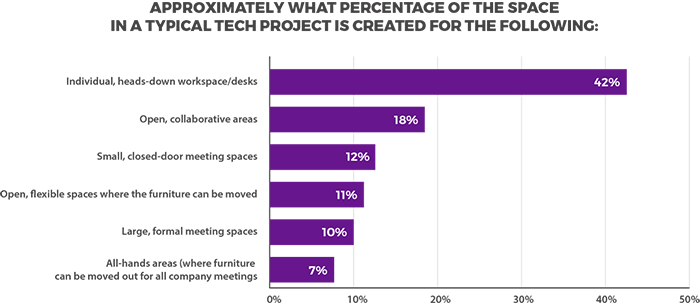- What's New
- Pricing & Purchasing
- Lead Times
- Literature & Samples
- Services & Warranties
- Careers
- Find a Rep
Me vs. We Space in Tech

Can you recall a time when you didn’t rely on your smart phone for your text messages, your work emails, social media notifications or for the latest news? It may seem like a lifetime ago but the iPhone was only introduced in 2007. The iPhone is just one example from an endless list of technologies that have drastically altered the way we communicate and how we work.
What’s even more eye-opening? The newest generation of worker can’t reference a time before what I’ve mentioned above. Brought up and educated as digital natives, current college students and recent grads, commonly referred to as Generation Z (born 1995 or later), and even the majority of Millennials have only studied and worked in environments that integrate and rely on technology to achieve basic daily tasks.
So where are we headed in the next 10 years? Will our current workplace tools be a faint memory like floppy disks and DSL?
The best places to turn for this answer are technology companies. It's common sense - they’re the creators and developers, the masterminds and innovators behind the newest technologies transforming work styles. Inevitably, the way tech employees work today will permeate into the average workplace tomorrow.
KI partners regularly with technology companies to space plan their office environments, giving us an insider perspective on their culture and where workplace environments are headed. In order to predict what’s next for the office, we reached out to architects and designers who work closely with tech clients to plan their environments.
We recently surveyed nearly 400 architects and designers across the U.S. who have worked with tech companies on projects within the last 2 years and asked for their feedback on what is driving tech culture.
What did we learn? Technology surfaced as one of the top three priorities of tech employees.
Let's dive into a few examples of tech innovations not only being developed but also being used by these companies. As you review these tools image how the workplace will have to morph to support these new resources.
- Big data – Large data sets can be analyzed to reveal patterns and trends about human behavior and interactions – meaning businesses can fluidly alter objectives, products and services in real-time to accommodate consumer behavior. The workplace affect - office spaces are becoming more team-based to help employees be more aligned and improve both quality and efficiency of work.
View KI's Connection Zone Benching Solution - Smart spaces - Companies are beginning to use IOT (Internet of Things) software that incorporates room booking, space utilization and meeting enablement. The technology is embedded within as many workplace systems as possible, allowing these systems to “speak” to each other, creating a personal experience for each employee.
For instance, software has the ability to give the location of employees (anonymously) throughout a building. Sensors throughout the office monitor activity and noise levels to get a pulse of utilization. An employee can walk into a space, the lights will dim to their preferred level based on their personal settings communicated through the software. Software can lower room temperature while pulling in conferencing options and presentations on demand.
- Virtual Reality – It’s estimated that Gen Z will adopt virtual reality with the same capacity that Millennials adopted smart devices and Gen X personal computing. Virtual reality is closing the gap between tracking, living and gaming software resulting in the rise of gamification in the office. Employees may start using VR in a number of different ways like virtual meetings and space mock-ups.
As tools like those noted above become commonplace and other technologies emerge, space needs are shifting. We also asked architects and designers what percentage of space in a typical tech project is created for specific uses; check out the results below.

The big takeaway here is that nearly 60% of space is devoted to things other than individual space, what we call “me vs. we” space. The need to collaborate with coworkers is starting to trump the need for dedicated individual space. As technology pushes our work styles and behaviors forward it’s also altering the physical workplace.
If you’d like to learn more about what’s driving tech culture, I encourage you to contact us to schedule our CEU, “Emerging Space: How the Technology Industry is Driving Workplace Change."
Subscribe
Stay up to date with the latest trends and more.


